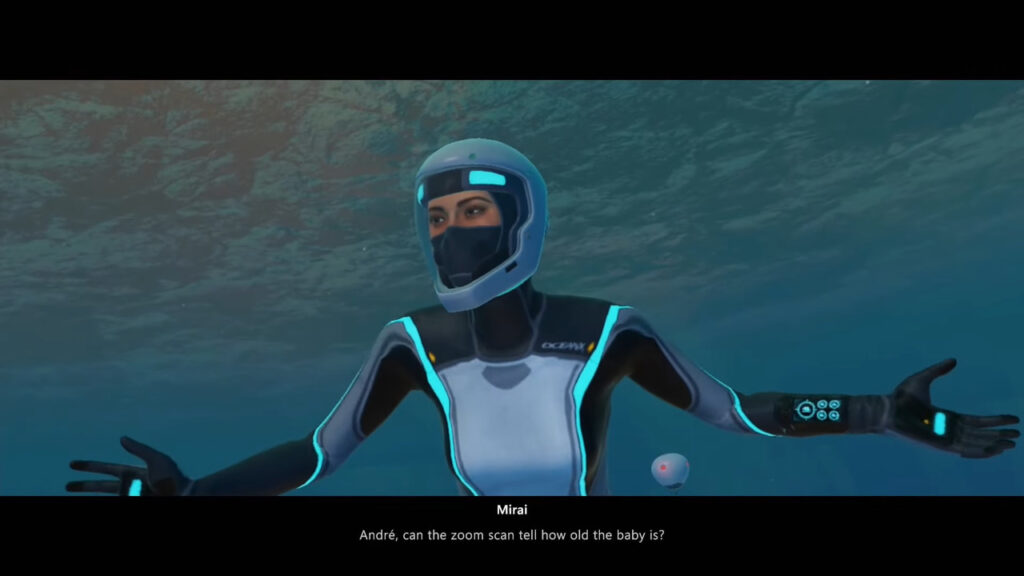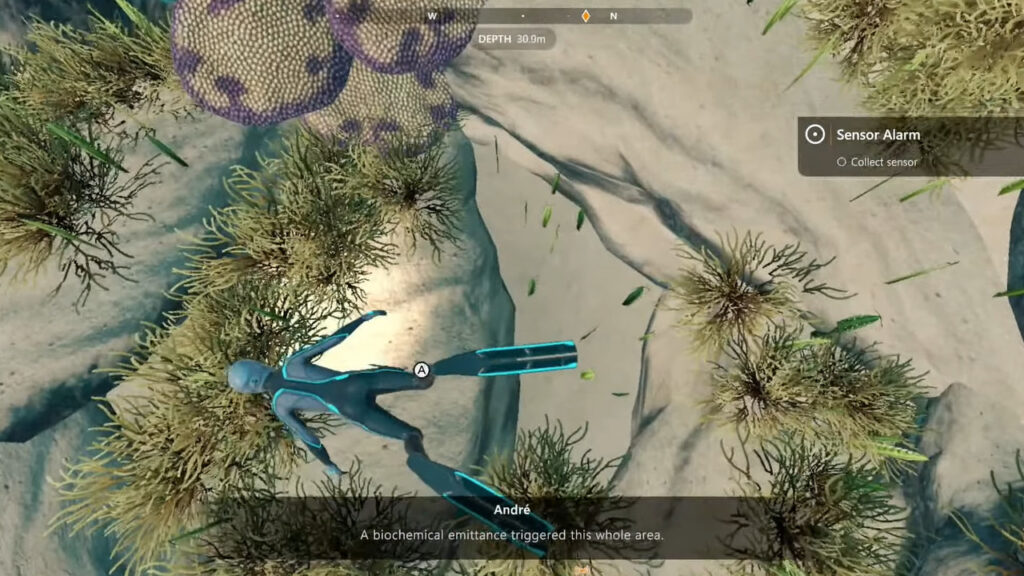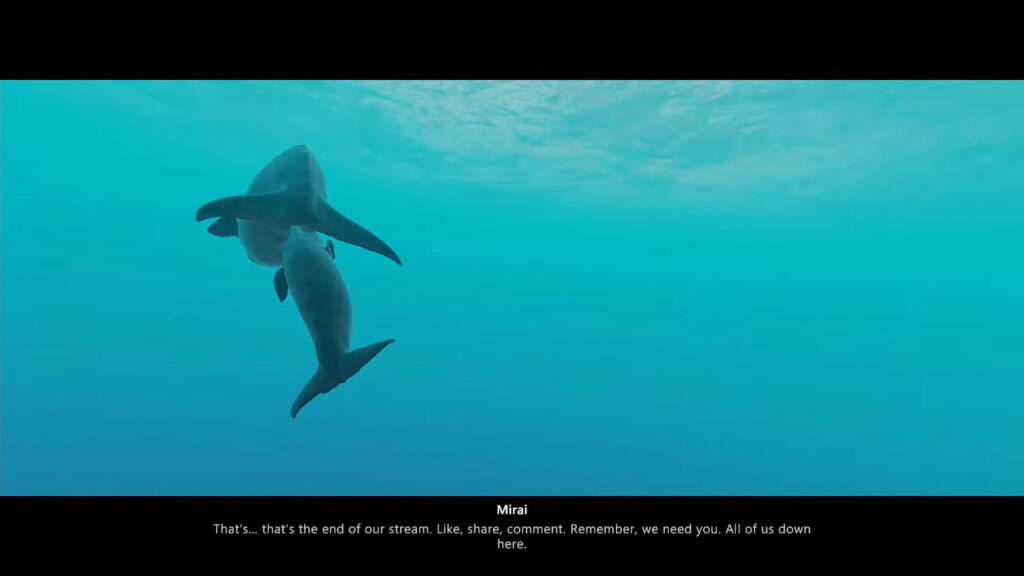
Developer: E-Line Media
Publisher: E-Line Media
Platform: PC, PS4, Xbox One, Switch
Tested on: Switch
Beyond Blue (Switch) – Review
Before we dive into our Beyond Blue review, let’s start by addressing the elephant in the room: this is an educational game first and foremost. Granted, it’s got some impressive credentials behind it. It was inspired by the BBC’s Blue Planet II documentary series and it received support from researchers that cooperate with the National Geographic Society. Of course, a significant portion of the game’s audience will dismiss Beyond Blue *because* it’s edutainment which automatically means it can’t be good, right? Well, not exactly. While Beyond Blue does suffer from some issues, these aren’t due to the game’s educational nature. So, what does Beyond Blue get wrong as a game, and more important: what does it get right?
Story
Beyond Blue’s narrative follows Mirai, a whale researcher and diver, working for the OceanX organisation. OceanX has recently deployed an experimental underwater research station -where Mirai is now stationed- to observe and document the behavior of a family of sperm whales. While working from this station, Mirai must go on dives to keep an eye on OceanX’s scanning equipment and investigate wildlife in real-time. It is during one of these dives that a mysterious sound draws the team’s attention. It is now up to Mirai to figure out the source of this mysterious noise.
The opening chapter of the game briefly touches upon how the communication between the various characters of the game works. Given that the majority of Beyond Blue’s narrative is delivered through radio dialogue, this makes sense, especially in an educational title. It’s a clever way to create a realistic dynamic between the cast while remaining within the game’s limitations. Through conversations in the underwater research station, which serves as the hub area, the relationships between the cast are explored and fleshed out further, which aids in making the cast more relatable and likeable.
Graphics
We’re aware that the Switch isn’t exactly a graphics powerhouse, but we were baffled with how dated and unpolished Beyond Blue appeared on our screen. The most egregious example where the seaweeds: the game clearly had issues with rendering these. We also noticed a significant frame rate drop whenever there was too much going on on-screen at the same time. This wouldn’t be so terrible if the in-game models looked overly detailed, but Beyond Blue’s depictions of ocean life look simplistic and rather dated. We can forgive the poor draw distance -there is less visibility in the ocean after all- but Beyond Blue’s overall visual presentation was disappointing.
Sound
One of the more remarkable aspects of Beyond Blue’s soundscape is in it’s soundtrack: music tracks aren’t original compositions. Instead, the game presents you with a playlist, which you can check out in the underwater research station. Real-world artists kindly licensed their music to E-Line Media free of charge, and the result is a somewhat eclectic mix of tunes that the player has full control over. It’s an odd mix, but the sheer selection of tunes makes it likely that there will at least be some music that appeals to the player.
The game also features full voice acting and the cast does an admirable job at bringing their characters to life -especially since most of them only appear as static images during Mirai’s conversations with them. Most of the characterisation of the humans in the game is done entirely through voice work, so we’re happy to see that Beyond Blue nailed this aspect. Finally, the game makes liberal use of real-world sound effects for the underwater world, including realistic clicks and cries from the whales that form an essential part of the story.
Gameplay
Diving games aren’t a new concept and Beyond Blue doesn’t cover any uncharted territory within the genre. Players take control of Mirai in a series of objective-based diving sessions as they make their way through the main story. These objectives typically involve swimming towards a target and then scanning it. It’s a bit of a shame to see how one-tone the gameplay is, especially during the three hours or so that it takes to play through the main story. Of course, the meat of any good diving game experience is in how fun and relaxing it is to explore the game’s recreation of the ocean. This is especially true in the post-game, where you’re free to explore to your heart’s content and where your task is to simply scan everything at your leisure to complete your database of underwater life.
Said database is where a large part of the ‘edutainment factor’ of Beyond Blue comes in. Not only does it include a massive list of facts about the inhabitants of the ocean, but also a series of unlockable documentary clips. Unfortunately, these clips suffer the same fate as the rest of the graphics -which is baffling as these are video files that shouldn’t require any real-time rendering- and the low frame rate was so obvious that the videos were pretty much unwatchable. We’re not sure whether this is the case with the other versions of the games or if this is the result of an unoptimized Switch port, but the videos as presented here are best not bothered with. Fortunately, it’s a part of the game that can be ignored entirely, though that undermines the game’s intent.
By ignoring the game’s educational aspect -and thus, its message to players- it becomes glaringly obvious that there isn’t a whole lot to what Beyond Blue has to offer. Exploring the ocean is oversimplified, with the player not even having to worry about oxygen. On the upside, the controls are elegant and easy to get to grips with. Scanning ocean life, your key task, is as simple as aiming at the subject and holding R while in scanning mode, with the only challenging aspect being that you need to keep up with its movement. You can scan pretty much everything, even when it isn’t relevant in story mode, to add it to your database. Beyond the woefully short story mode however, there is simply no reason to really engage with the game. There are no hidden surprises, no secret areas to explore, and nothing to do apart from scanning everything in sight in the hope that you haven’t done so before. For a game that focuses on magnificent and impressive creatures such as various whale species, Beyond Blue simply lacks the wow factor. Given that diving game enthusiasts are spoilt for choice these days, it’s easy to skip Beyond Blue.
Conclusion
We really wanted to like Beyond Blue, but were left with a bitter aftertaste once the credits rolled. The lack of meaningful gameplay, the disappointing visuals, and the frustratingly short length of the story mode added up to a title that we find hard to recommend. The PC, PS4 or Xbox versions of the game may fare a little better on the graphics front, especially when it comes to the framerate of the documentary clips, but even slightly better visuals aren’t going to be enough to make this a title worth your time, especially since there are better alternatives out there.
Beyond Blue (Switch) - Review,









No Comments